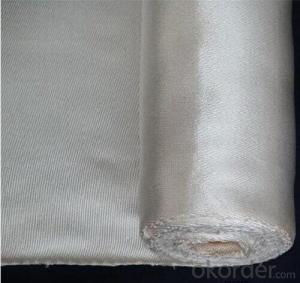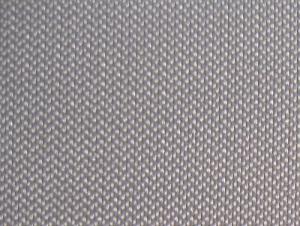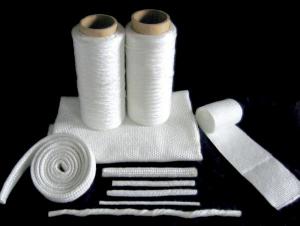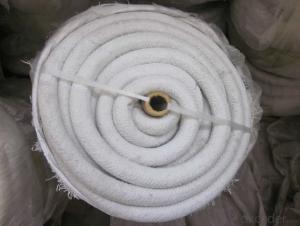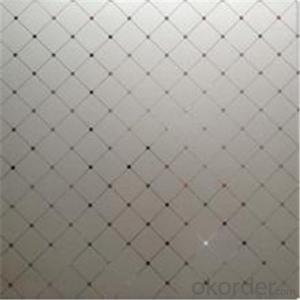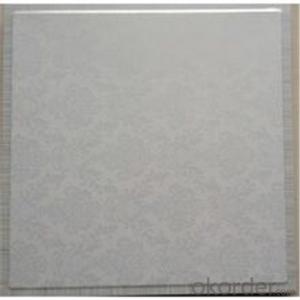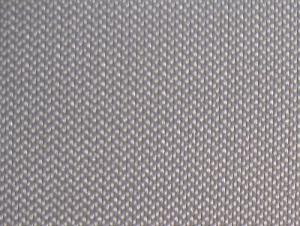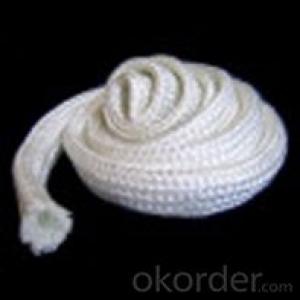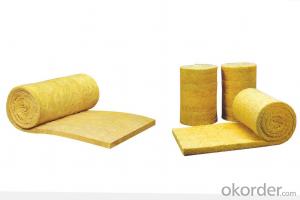Alumina Coated Glass Fiber Fabric Product
- Loading Port:
- Qingdao
- Payment Terms:
- TT OR LC
- Min Order Qty:
- 500 m²
- Supply Capability:
- 3000 m²/month
OKorder Service Pledge
OKorder Financial Service
You Might Also Like
Alumina Coated Fiberglass Fabric is made of important fiberglass as the wearing material to plain knit or specially knit into superior fiberglass basic cloth,coat it with fine PTFE resin then make it into various of Teflon high temperature resistance cloth in different thickness and width .
Besides ,having the grate capability of antisepsis and heat resistant, the surface is more smoothly and it has better non-viscidity capability. It could be used in ordinary industry field, and has better predominance on being used as plastic module separating, and separating patch, gasket, separating module of some products.
PRODUCT FEATURES AND BENEFITS*
* stable dimension, high intensity, elongation coefficient less 5%
* good temperature resistance,24 hours working temperature -70~260oC
* low coefficient of friction and dielectric constant, good insulating ability
* non-stick, easy to clear stains and adhensive on the surface
* good chemical resistance, it can resist all most of chemical medicines, acids, alkalis and salt, it is fireproof, lower in aging.
*With excellent heat resistance, rub resistance, high insulation properties, high tensile strength, oil resistance, corrosion resistance, flame resistance, non-halogen properties
Model | Thickness (mm) | Color | Width (mm) | Normal Weight (g/m²) | Tensile strength (N/cm) | Peeling strength (N/25mm) | Heat resistance (℃) |
CT - TF008 | 0.08 |
Brown *White *Black *Beige
| 1250 | 150 | 180/140 | 6.5-9.5 | -60~260 |
CT-TF013 | 0.13 | 1250 | 260 | 290/260 | 6.5-9.5 | -60~260 | |
CT-TF015 | 0.15 | 1250 | 300 | 310/260 | 6.5-9.5 | -60~260 | |
CT-TF018 | 0.18 | 1250 | 330 | 400/260 | 6.5-9.5 | -60~260 | |
CT-TF025 | 0.25 | 2800 | 450 | 550/500 | 6.5-9.5 | -60~260 | |
CT-TF035 | 0.35 | 3200 | 700 | 650/600 | 6.5-9.5 | -60~260 | |
CT-TF040 | 0.40 | 3500 | 780 | 820/500 | 6.5-9.5 | -60~260 | |
CT-TF065 | 0.65 | 4000 | 1100 | 880/730 | 6.5-9.5 | -60~260 | |
CT-TF09 | 0.9 | 4000 | 1500 | 1050/950 | 6.5-9.5 | -60~260 |
- Q:Are glass fiber textiles suitable for making carpets or rugs?
- Glass fiber textiles are not commonly used for making carpets or rugs. While glass fiber has excellent properties such as high strength, durability, and resistance to moisture, it lacks the softness and comfort required for a carpet or rug. Glass fiber textiles are more commonly used in applications such as insulation, reinforcement in composites, and as a substitute for asbestos. Carpets and rugs, on the other hand, are typically made from natural or synthetic fibers such as wool, nylon, or polyester, which provide the necessary qualities of softness, warmth, and comfort underfoot. Therefore, glass fiber textiles are not suitable for making carpets or rugs.
- Q:How does glass fiber textile perform in terms of water repellency?
- Glass fiber textile is not inherently water repellent. However, it can be treated with water repellent coatings or finishes to enhance its water resistance properties. These coatings create a hydrophobic barrier on the surface of the glass fibers, causing water to bead up and roll off instead of being absorbed. The level of water repellency achieved depends on the quality and type of coating used. With proper treatment, glass fiber textile can provide good water repellency, making it suitable for applications where protection against water intrusion is desired.
- Q:Can glass fiber textiles be used in garden or agricultural products?
- Glass fiber textiles have a wide range of uses in garden and agricultural products. They are known for their strength, durability, and ability to resist moisture and chemicals. In the garden industry, glass fiber textiles can be utilized in plant pots, garden furniture, and trellises. These textiles provide strong support and stability for plants, allowing them to grow properly. They are also resistant to rotting, warping, and damage from insects, making them perfect for outdoor use. In agriculture, glass fiber textiles are commonly used in greenhouse construction. They can be used as a covering material to insulate and protect plants from harsh weather conditions. Despite being lightweight, these textiles are strong enough to allow sunlight to pass through while shielding plants from excessive heat and harmful UV radiation. Moreover, glass fiber textiles are suitable for manufacturing agricultural nets and shade cloths. These textiles offer protection against pests, birds, and other harmful elements, allowing crops to grow undisturbed. They are also resistant to commonly used agricultural chemicals, ensuring long-lasting performance. In conclusion, glass fiber textiles are a durable and versatile choice for garden and agricultural products. Their resistance to moisture and chemicals, strength, and durability make them reliable for various applications in these industries.
- Q:Are glass fiber textiles suitable for medical applications?
- Yes, glass fiber textiles are suitable for medical applications. They possess excellent properties such as high strength, durability, and resistance to chemicals, making them suitable for use in surgical gowns, wound dressings, and medical implants. Additionally, their non-toxic nature and ability to be easily sterilized further enhance their suitability for medical applications.
- Q:Can glass fiber textile be used in solar panels?
- Glass fiber textile is indeed suitable for utilization in solar panels. Possessing outstanding electrical insulation properties, this lightweight and flexible material can serve as a substrate or backing for solar panels, providing valuable structural support and safeguarding the fragile solar cells. By incorporating glass fiber textile, the longevity of solar panels is enhanced, as it resists weathering, moisture, and UV radiation. Furthermore, the flexibility of glass fiber textile facilitates seamless integration into diverse solar panel designs, offering increased installation options. Consequently, the utilization of glass fiber textile in solar panels contributes significantly to their overall efficiency and durability.
- Q:Can glass fiber textiles be used in reinforcement of foam materials?
- Yes, glass fiber textiles can be used in the reinforcement of foam materials. Glass fibers are commonly used as a reinforcing material due to their high strength and ability to improve the mechanical properties of various materials, including foam. By incorporating glass fiber textiles into foam materials, the resulting composite can have enhanced tensile strength, durability, and resistance to deformation, making it suitable for a wide range of applications such as automotive parts, construction materials, and sports equipment.
- Q:How do glass fiber textiles contribute to stain resistance?
- Stain resistance is enhanced by the inherent properties of glass fiber textiles. Due to their non-porous nature and smooth surface, glass fibers pose difficulty for stains to penetrate and adhere to the fabric. This prevention of absorption effectively stops liquid stains, like food and beverage spills, from seeping into the fabric and causing permanent discoloration. Moreover, the smooth surface of glass fibers simplifies the process of cleaning and stain removal. In contrast to rougher textiles, glass fiber textiles offer easy wiping away of stains, thereby minimizing the risk of permanent staining. Additionally, glass fibers display resistance to chemicals and can endure harsh cleaning agents. This allows for more efficient stain removal without causing damage to the fabric. Ultimately, the distinctive properties of glass fiber textiles contribute to their stain resistance, rendering them a robust and practical choice for various applications.
- Q:Can glass fiber textiles be used for making protective clothing?
- Glass fiber textiles have the capability to be utilized in the creation of protective clothing. These textiles are produced by weaving glass fibers together, resulting in materials that possess impressive strength and resistance to high temperatures. Consequently, they are well-suited for industries involving firefighting, welding, and chemical handling, where individuals face significant risks of exposure to heat, flames, or chemicals. In fact, glass fiber textiles are highly efficient in providing insulation and shielding against heat, fire, and select chemicals, making them an optimal selection for protective clothing. Furthermore, these textiles are lightweight, flexible, and long-lasting, facilitating ease of movement and prolonged durability even in challenging environments. It is essential, however, to bear in mind that glass fibers can cause irritation to the skin and respiratory system. Therefore, it is crucial to observe appropriate precautions and safety measures when working with glass fiber textiles and wearing the resultant protective clothing.
- Q:Can glass fiber textiles be used in medical implants?
- Yes, glass fiber textiles can be used in medical implants. Glass fibers are known for their high strength and durability, making them suitable for various applications, including medical implants. In medical fields such as orthopedics and tissue engineering, glass fiber textiles have been utilized for their ability to reinforce and strengthen implants. These textiles can be incorporated into implants such as bone plates, screws, and scaffolds, providing mechanical support and promoting healing. Additionally, glass fibers can be surface-modified to enhance biocompatibility and minimize adverse tissue reactions. However, it is important to note that the specific use of glass fiber textiles in medical implants should be carefully evaluated and approved by regulatory bodies to ensure safety and efficacy.
- Q:What are the different forms of glass fiber textile?
- The different forms of glass fiber textile include glass fiber yarns, glass fiber rovings, glass fiber fabrics, glass fiber mats, and glass fiber tapes.
1. Manufacturer Overview |
|
|---|---|
| Location | |
| Year Established | |
| Annual Output Value | |
| Main Markets | |
| Company Certifications | |
2. Manufacturer Certificates |
|
|---|---|
| a) Certification Name | |
| Range | |
| Reference | |
| Validity Period | |
3. Manufacturer Capability |
|
|---|---|
| a)Trade Capacity | |
| Nearest Port | |
| Export Percentage | |
| No.of Employees in Trade Department | |
| Language Spoken: | |
| b)Factory Information | |
| Factory Size: | |
| No. of Production Lines | |
| Contract Manufacturing | |
| Product Price Range | |
Send your message to us
Alumina Coated Glass Fiber Fabric Product
- Loading Port:
- Qingdao
- Payment Terms:
- TT OR LC
- Min Order Qty:
- 500 m²
- Supply Capability:
- 3000 m²/month
OKorder Service Pledge
OKorder Financial Service
Similar products
New products
Hot products
Hot Searches
Related keywords
